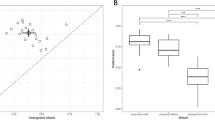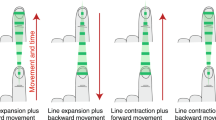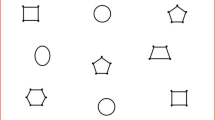Abstract
The strategies of action employed by a human subject in order to perceive simple 2-D forms on the basis of tactile sensory feedback have been modelled by an explicit computer algorithm. The modelling process has been constrained and informed by the capacity of human subjects both to consciously describe their own strategies, and to apply explicit strategies; thus, the strategies effectively employed by the human subject have been influenced by the modelling process itself. On this basis, good qualitative and semi-quantitative agreement has been achieved between the trajectories produced by a human subject, and the traces produced by a computer algorithm. The advantage of this “reciprocal modelling” option, besides facilitating agreement between the algorithm and the empirically observed trajectories, is that the theoretical model provides an explanation, and not just a description, of the active perception of the human subject.
Similar content being viewed by others
REFERENCES
Bach-y-Rita, P. (1972), Brain Mechanisms in Sensory Substitution, New York: Academic Press.
Brooks, R.A. (1987), Intelligence Without Representation, Boston: MIT Artificial Intelligence Report.
Crowley, J.L. & Christensen H. I. (1995), Vision as Process. Basic Research on Computer Vision Systems, Berlin: Springer.
Gapenne, O., Lenay, C., Stewart, J., Bériot, H. and Meidine, D. (2001), Prosthetic Device and 2D Form Perception: The Role of Increasing Degrees of Parallelism; in Proceedings of the Conference on Assistive Technology for Vision and Hearing Impairement (CVHI'2001), Castelvecchio Pascoli, Italy.
Gibson, J.J. (1979), The Ecological Approach to Visual Perception, Boston: Houghton Mifflin Press.
Gullaud, L. and Vinter, A. (1996), The Role of Visual and Proprioceptive Information in Mirrordrawing Behavior, in M.L. Simmel, C.G. Leedham & A.J.W.M. Thomassen, eds., Handwriting and Drawing Research: Basic and Applied Issues, Amsterdam: IOS Press, pp. 99–113.
Hanneton S., Gapenne O., Genouel C., Lenay C. and Marque C. (1999), Dynamics of Shape Recognition Through a Minimal Visuo-Tactile Sensory Substitution Interface, in Proceedings of the Third International Conference On Cognitive and Neural Systems, Boston, pp. 26–29.
Kiper, D.C. & Carandini, M. (2002), The Neural Basis of Pattern Vision, London: Macmillan.
Lenay, C., Cannu S. and Villon, P. (1997), Technology and Perception: The Contribution of Sensory Substitution Systems, in Proceedings of the Second International Conference on Cognitive Technology, Aizu, Japan, Los Alamitos: IEEE, pp. 44–53.
Lenay, C., Gapenne, O., Hanneton, S. and Stewart, J. (1999), Perception et Couplage Sensori-Moteur: Expériences et Discussion Epistémologique, in A. Drogoul and J-A. Meyer, eds., Intelligence Artificielle Située (IAS'99), Paris: Hermes, pp. 71–86.
Mandik P. (1999), Qualia, Space and Control, Philosophical Psychology 12(1), pp. 47–60.
Maturana, H. and Varela, F.J. (1987), The Tree of Knowledge, Boston: Shambhala.
Marr, D. (1982), Vision: A Computational Investigation into the Human Representation and Processing of Visual Information, San Francisco: W.H. Freeman.
O'Regan J.K. and \(\begin{gathered} ` \hfill \\ {\text{No}}{\text{e}} \hfill \\ \end{gathered} \) A. (2001), A Sensorimotor Account of Vision and Visual Consciousness. Behavioral and Brain Sciences 24, pp. 939–1031.
Piaget J. (1967), Biologie et connaissance: Essai sur les relations entre les régulations organiques et les processus cognitifs, Paris: Gallimard.
Poggio, T. (1983), Visual Algorithms, in O.J. Braddick and A.C. Sleigh, eds., Physical and Biological Processing of Images, Berlin: Springer, pp. 128–153.
Powers, W.T. (1988), An Outline of Control Theory, in The Control Systems Group Inc., Living Control Systems, Kentucky, USA, pp. 253–293.
Schillings, J.J., Meulenbroek, G.J. and Thomassen, A.J.W.M. (1996), Decomposing Trajectory Modifications: Pen-Tip Versus Joint Kinematics, in M.L. Simmel, C.G. Leedham and A.J.W.M. Thomassen, eds., Handwriting and Drawing Research: Basic and Applied Issues, Amsterdam: IOS Press, pp. 71–85.
Stewart J. (1996), Cognition = Life: Implications for higher-level cognition, Behavioural Processes 35, pp. 311–326.
Ullman, S. (1980), Against Direct Perception, Behavioral and Brain Sciences 3, pp. 373–415.
Varela F., Thompson E. and Rosch E. (1993). The Embodied Mind, Boston: MIT Press.
Author information
Authors and Affiliations
Rights and permissions
About this article
Cite this article
Stewart, J., Gapenne, O. Reciprocal Modelling of Active Perception of 2-D Forms in a Simple Tactile-Vision Substitution System. Minds and Machines 14, 309–330 (2004). https://doi.org/10.1023/B:MIND.0000035423.93112.b2
Issue Date:
DOI: https://doi.org/10.1023/B:MIND.0000035423.93112.b2




